Mother Goose
and other earth histories
Mother Goose is a podcast series on folktales, earth knowledge, and agroecology.
Folktales and stories have been passed on by ancestors. We try to listen to what they tell us about the earth to become better allies.
This podcast is funded by the Creative Work Fund in collaboration with Earth Activist Training and la Fondation des Artistes.
Spotify
Soundcloud
Stitcher
Google podcast
Sunshine is a mother from Standing Rock Reservation, a graduate from Sitting Bull College with a Bachelor’s in Environmental Science, a permaculture teacher, manages the Regenerative Land classes with Earth activist training.
She is a current board member of the Mni Wiconi Integrated Health Clinic, that was seeded by the water protector camp, which is set to open Fall 2021, works on food sovereignty with local youth, and plants trees wherever she can. Sunshine shares earth stories she grew up with and talks about the landscape she tends.
Mother Goose and other Earth stories was made possible with the help of a Creative Work Fund Grant for a collaboration between Earth Activist Training and Suzanne Husky.
Ma mère l’oie et autres histoires de la terre est un projet qui a été sélectionné par la commission mécénat de la Fondation des Artistes qui lui a apporté son soutien.
Image : America's got talon
Bald eagle (Haliaeetus leucocephalus)
Family: Accipitridae
© Robert David Siegel, M.D., Ph.D.

In this episode, medievalist Clovis Maillet who recently wrote a book called “Fluid Genres, from Joan of Arc to trans saints” shares some of his research on trans saints in medieval times. Clovis talks about the context in which folks may decide to endorse different gender identities throughout their lives and shares the tales of the influential trans saints Marina, and St Eugenia of Rome, that chose to be men all their lives for various reasons. To help us understand the world view of European medieval times, he goes into the importance of virginity in relation to social status, the accepted social place of hermaphrodites, how women are perceived, and more aspects of life that challenge our ‘modernity”.
Music : Public domain Hildegard of Bigen, Viridissima virga
Image : Northern Fulmar (Fulmarus glacialis). Suzanne Husky
Ce projet a été sélectionné par la commission mécénat de la Fondation des Artistes qui lui a apporté son soutien. This podcast was made possible with the support of the Creative Work Fund in collaboration with Earth Activist Training

Kissing the ground, wishing for daughters over sons, walking the world with a wing or a goose foot, we find in folktales vestiges of long gone world-views, traces of earth based spirituality, myths, matrilineal societies and more. In this conversation with Starhawk, philosopher, environmental activist, whitch, science fiction writer, and the founder of Earth Activist Training we talk about why folktale matter in relation to activism and for women. We focus in particular on The twelve wild swans, a folktale the Reclaiming community has deeply activated through rituals and about which Starhawk has written a book with Hilary Valentine called The twelve wild swans, a journey to the realm of magic, healing, and action.
Mother Goose and other Earth stories was made possible with the help of a Creative Work Fund Grant for a collaboration between Earth Activist Training and Suzanne Husky.
Ma mère l’oie et autres histoires de la terre est un projet qui a été sélectionné par la commission mécénat de la Fondation des Artistes qui lui a apporté son soutien.
Image Muscovy duck (Cairina moschata)
Family: Anatidae (ducks, geese, swans)
© Robert David Siegel, M.D., Ph.D.

There is an animal that can help us out of the drought and fires paradigm we live in. He can keep our rivers from becoming deep incisions in the land and raise water tables. He can create habitats for fish, butterflies, birds, and provide food for herbivores. He can keep nitrates and phosphorus from being bleached straight to the oceans and filter heavy metal pollution residues from mining, and suspend herbicides. His teeth are partially metal and never stop growing, he’s a system engineer. He is often at the bottom of the totem pole because he is a keystone species. He’s the beaver and before the whites came, millions and millions of dams turned rivers into broad valleys of life throughout Turtle island.
The fur trade, followed by valley agriculture, followed by rodent hatred blinded (some of ) us from seeing the central role of the ecosystem builder, the beaver.
My guest is Ben Goldfarb, journalist and author of Eager, The Surprising, Secret Life of Beavers, and Why They Matter
Image : Beaver back paw, creative commons
Music : Paul Husky

Fleeing ‘power over’ to develop ‘power with’, aspiring for a lighter footprint by immersing in the wild, living off the grid in extreme weather, on top of a pole, on an island, in a tree, in a cave only eating raw lentils, walling yourself in, eating raw food, plants only, grazing like dear or having a pescatarian diet? Talking to birds, wolves, and having pet lions carry wood? These are all things hermits did.
That is why when you need advice, over and over, in folktale, and spirituality, you consult the hermit, or the crone (who is also a hermit). In this episode of Mother goose and other earth stories, medievalist Andrew Jotischky, author of the book A Hermit’s Cookbook. Monks, Food, and Fasting in the Middle Ages give us insight into the history of hermeticism and its discontent with dominant culture or quest for spiritual growth - in the middle east and Europe. PS: Amending your garden with a grotto and an employed hermit was a thing.
Guest : Andrew Jotischky
Book referrer to A Hermit’s Cookbook. Monks, Food and Fasting in the Middle Ages, Andrew Jotischky
Music, Paul Husky
Violon: Lucy Petrou
Image : Layla visits Majnun in the wilderness surrounded by animals (IO Islamic 384, f. 42r)

2000-year-old cloth fragments with giant shelf mushrooms, lingzhi farms in the lands of the immortals, goddesses whose soul turns into grass and whose body turns into lingzhi, a feather woman living 170 years, pine needle diets... In this episode, I talk with eco-art historian Yu Chuan Chen about Lingzhi, Ganoderma lingzhi. Yu Chuan Chen researched the relation between mushrooms and sacred geographies and curated an exhibition at the Cantor art center at Stanford in 2017, A mushroom’s perspective on sacred geographies. What if immortals had given mushrooms and medicinal plants to mortals in order to incite them to go into the woods and the mountains to search for them? His research focuses on East Asia (Japan, Korea, China). We talk about artifacts, myths, and folktales where Linzhi and other mushrooms are associated with sacred sites or spiritual growth.
Image: Rai artist, Nepal, Mask for a Guardian Spirit, 19th century
Fungus, lacquer, and nails
Iris & B. Gerald Cantor Center for Visual Arts at Stanford University; Gift of Dwight and Blossom Strong, 2001.139
Music: Paul Husky, Lucie Petrou

In this episode, we try to remember how we have tended the land in the past and we dive into European medieval woods with Paolo Squatriti. We focus on the care of one tree, the chestnut.
Chestnut was initially rare, then with the help of humans and potentially a wood mouse was turned into the delicious nuts we now know. But it took a 1000 years of stewarding and grafting and feeding that tree to make that happen. The chestnut is the food that helps resist the grain of empire. In those forests live hermits working on spiritual growth, abbots destroying trees sacred to pagans, monks wearing chestnut-colored robes to tend the sheep whose skins they will write manuscripts on, and chestnut “matricinas” - mother trees- sacred elder trees that were protected over time.
Remembering how active forests used to be is not to invite folks to consume the spectacle of the forest but to learn about agroforestry. We read from folktales that mention chestnuts.
Book : Land and change in early medieval Italy, Chestnut, Economy and Culture, Paolo Squatriti
Image : Double-crested cormorant (Phalacrocorax auritus floridanus)© Robert David Siegel, M.D., Ph.D. Stanford Uni
Music : Paul Husky. Violon : Lucie Petrou

The Three Little Pigs -
Conversation with medievalist Jamie Kreiner
One of the species humans co evolved with are pigs. In the well known folktale The 3 little pigs, Pigs are strangely builders, architects, and maybe social climbers, why is that? Medievalist Jamie Kreiner writes: “ The working relationship between humans and pigs came to shape not only patterns of farming and eating but also regional economies, legal cultures, physical policies, identities, and philosophies of the cosmos". Her book is Legions of pigs in the early medieval west”. “Pigs world view has also changed “ she writes. In the following interview, we talk about certain parts of her vast research, and dive into the early medieval west world view where all creatures were a divine manifestation. ... then we sidetrack on bones.
Book : Legions of Pigs in Early Medieval West by Jamie Kreiner
Image : Medieval Marginalia
Music : Paul Husky. Violon : Lucie Petrou

